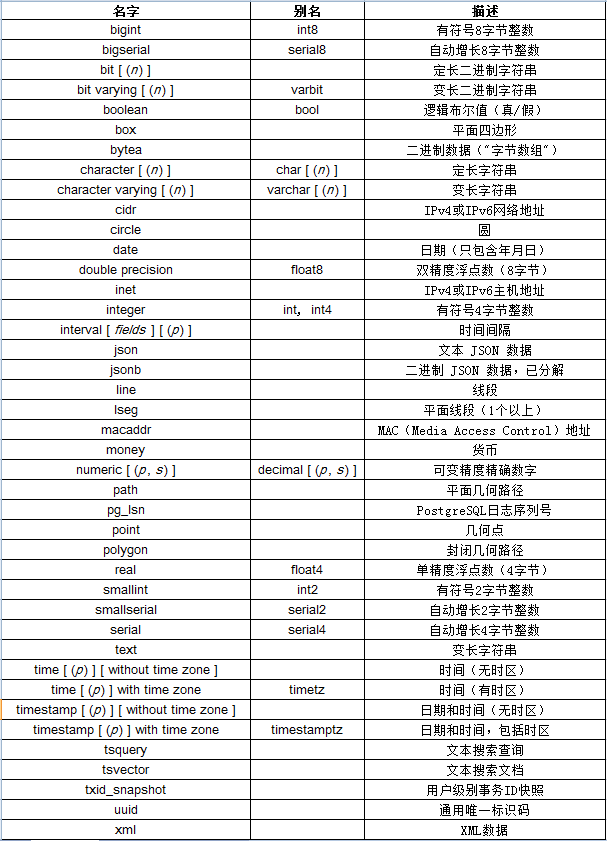PostgreSQL相对于其他数据库,支持数据类型很多。
PostgreSQL数据类型有布尔类型、整数类型、字符串类型、二进制字符串类型、位串类型、时间与日期类型、枚举类型、几何类型、网络地址类型、数组类型、复合类型、XML类型、json类型、range类型、对象标识符类型、伪类型和其他类型。
为提高SQL语句兼容性,部分数据类型还有别名,例如integer类型,可以用int、int4表示,smallint类型可以用int2表示等。具体情况见下图

数据输入和转换
简单数据可以直接查询输出。复杂类型可以用类型名加单引号进行输入。
postgres=# select 1 AS "1",1.414 AS "Sqrt(2)!=!",'Hello,Tom';
1 | Sqrt(2)!=! | ?column?
---+------------+-----------
1 | 1.414 | Hello,Tom
(1 行记录)
#查询复杂类型
postgres=#
postgres=# select smallint '777';
int2
------
777
(1 行记录)
postgres=#
postgres=#
postgres=# select int '777';
int4
------
777
(1 行记录)
postgres=#
postgres=# select int '777' + smallint '666';
?column?
----------
1443
(1 行记录)
postgres=#
PostgreSQL支持标准SQL类型转换函数CAST进行数据类型转换。也可以使用双冒号进行转换。
postgres=# select cast('2017' as int ),cast('2015-1-1' as date);
int4 | date
------+------------
2017 | 2015-01-01
(1 行记录)
#双冒号转换
postgres=# select '777'::int,'2015-1-1'::date;
int4 | date
------+------------
777 | 2015-01-01
(1 行记录)
postgres=#
#单引号可以省略
postgres=# select '0'::boolean,'0'::int;
bool | int4
------+------
f | 0
(1 行记录)
postgres=#
Boolean类型(布尔类型)
布尔类型只有两种状态,分别是true(真)和false(假)。
创建布尔类型测试表并插入数据。
postgres=# create table testbool(id int,status boolean);
CREATE TABLE
postgres=#
postgres=# insert into testbool values(1,True),(1,True),(2,'True'),(3,'true'),(4,'0'),(5,'1'),(6,'t'),(7,'f');
INSERT 0 5
postgres=#
#查询结果为t或f。
postgres=# select * from testbool;
id | status
----+--------
1 | t
1 | t
2 | t
3 | t
4 | f
5 | t
6 | t
7 | f
(8 行记录)
postgres=#
根据查询结果可知,布尔类型可以用带或者不带单引号不区分大小写true或false表示;0或1,t或f需要加单引号,0表示false,1表示true。
布尔类型可用操作符有逻辑运算符和比较运算符。
常用逻辑操作符有and、or和not。
SQL使用三个值,分别是true,false和null。null代表空值(什么都没有,不是0,也不是空格)。逻辑与和逻辑或运算前后两个操作对象位置可以互换,不影响运算结果。例如true and false 和false and true 查询结果相同。
不含null,2个值全部为真逻辑与运算结果为真,其他为假。
不含null,2个值全部为假逻辑或运算结果为假,其他为真。
true和null逻辑与运算结果为空,逻辑或运算结果为true。 false和null逻辑或运算结果为false,逻辑或运算结果为null。
两个空值逻辑或和逻辑与运算结果为null。
逻辑非运算也就是取反,非真为假,非假为真。下面看演示查询代码。
#bool数据类型练习
postgres=# select true and true,true and false,false and false;
?column? | ?column? | ?column?
----------+----------+----------
t | f | f
(1 行记录)
postgres=# select true or true,true or false,false or false;
?column? | ?column? | ?column?
----------+----------+----------
t | t | f
(1 行记录)
postgres=# select false and true,false or true;
?column? | ?column?
----------+----------
f | t
(1 行记录)
postgres=#
postgres=# select true and true,true and false,false and false;
?column? | ?column? | ?column?
----------+----------+----------
t | f | f
(1 行记录)
postgres=# select true or true,true or false,false or false;
?column? | ?column? | ?column?
----------+----------+----------
t | t | f
(1 行记录)
postgres=# select false and true,false or true;
?column? | ?column?
----------+----------
f | t
(1 行记录)
postgres=# select true and null,true or null;
?column? | ?column?
----------+----------
| t
(1 行记录)
postgres=# select false and null,false or null;
?column? | ?column?
----------+----------
f |
(1 行记录)
postgres=# select true and null,false and null;
?column? | ?column?
----------+----------
| f
(1 行记录)
postgres=# select not null;
?column?
----------
(1 行记录)
postgres=#
来源:oschina
链接:https://my.oschina.net/u/1011130/blog/1563271